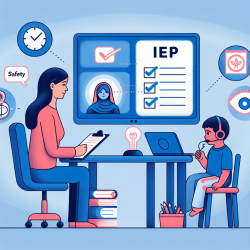As Special Education Directors, we constantly navigate the challenging waters of providing top-notch education and support to our students while ensuring their safety and well-being. In recent years, the emergence of telepractice, especially in speech therapy, has opened new avenues for us to achieve these goals more effectively. However, the concept of telepractice might still feel new or even overwhelming for some, particularly when considering its application within the intricate framework of Individualized Education Programs (IEP) and the broader special education landscape.
Telepractice, or the delivery of therapy services via online platforms, has proven to be a lifeline for many schools and students, especially in the face of therapist staffing shortages and the ongoing need for remote learning options due to health concerns. This method of service delivery not only adheres to the safety measures necessitated by the current global situation but also offers flexibility and accessibility that traditional in-person therapy sessions might not always provide.
For special education funding agencies and school districts alike, understanding the benefits and implementation of telepractice within the context of IEPs is crucial. It ensures that students receive the necessary support to meet their educational and therapeutic goals in a manner that prioritizes their safety. Here are several key aspects of how telepractice can enhance safety and support in special education:
- Accessibility: Telepractice overcomes geographical and physical barriers, providing students with access to specialized services, such as speech therapy, regardless of their location or mobility limitations.
- Customization: Therapy sessions via telepractice can be easily tailored to meet the individual needs of each student, aligning with the goals outlined in their IEPs.
- Engagement: The use of digital tools and interactive platforms can increase student engagement, making therapy sessions more effective and enjoyable.
- Safety: By offering services remotely, telepractice minimizes health risks associated with physical contact and large group settings, ensuring a safe learning environment for students and staff.
As we continue to advocate for the resources and support necessary to fulfill our mission in special education, it's important to embrace innovative solutions like speech therapy telepractice. It not only addresses the immediate challenges we face but also paves the way for a more inclusive, accessible, and safe educational landscape.
In conclusion, the integration of telepractice into special education services represents a significant step forward in our ongoing effort to provide safe, effective, and personalized support to every student. By leveraging technology, we can ensure that our students not only meet their IEP goals but thrive in an environment that respects and prioritizes their well-being.










